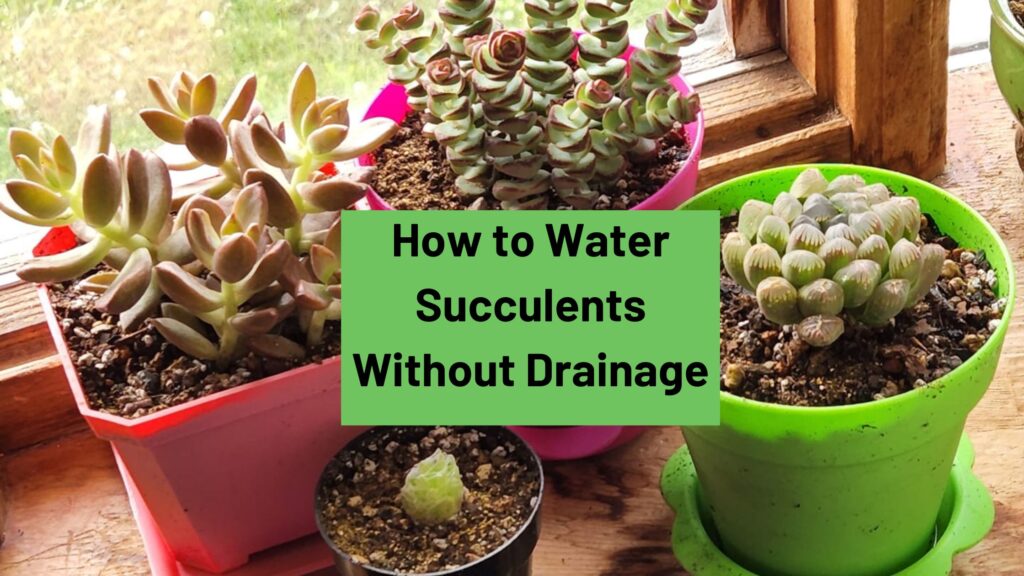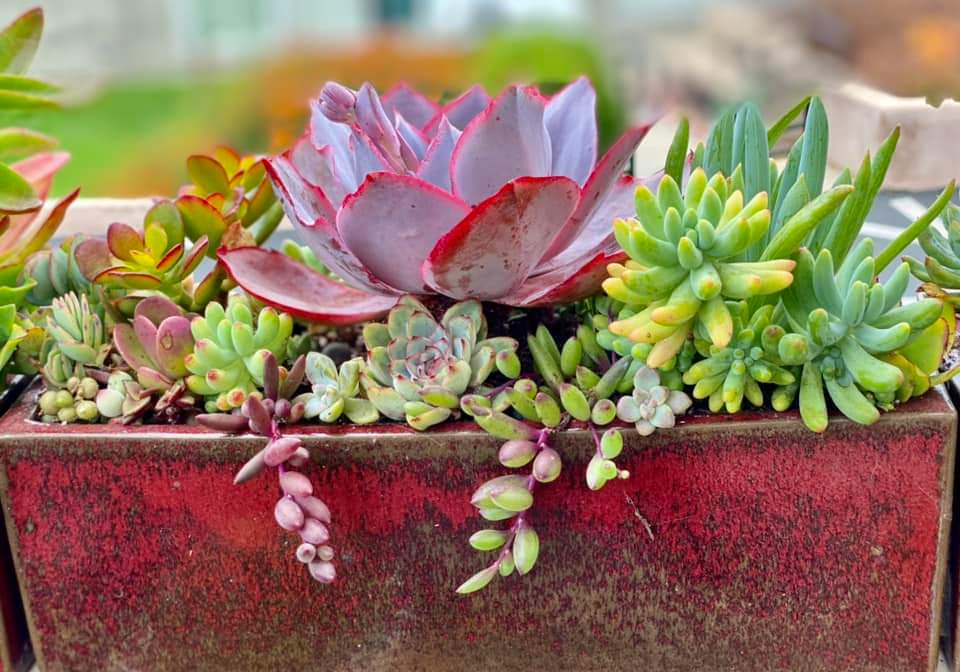So, you found beautiful pots that would complement your home’s aesthetics, and now you wonder whether you can grow your succulents in them.
Succulents are mostly easy-go plants that even beginners can manage to keep alive. However, one thing you must absolutely get right is watering.
You can easily overwater your succulents and even kill them in the process. In that case, how do you water succulents without drainage?
Can A Succulent Survive Without Drainage Holes?
A succulent can survive without drainage holes, but you must be extremely cautious with your watering practices. Succulents are adapted to arid environments and have water-storing tissues that let them withstand drought conditions.
However, they are also susceptible to root rot if you consistently expose them to excess water, which can happen in pots with no drainage holes.
Related Post: How To Water Succulents
Drainage holes keep water from pooling and saturating the soil. Without drainage holes, excess water won’t have anywhere to go, and the roots may become waterlogged, leading to rot and the plant’s eventual death.
Therefore, if you plan to grow a succulent in a pot without drainage holes, water the plant sparingly and monitor the soil’s moisture level closely to avoid overwatering your succulents. Using a well-draining succulent soil mix can also help improve water management.
However, even with careful watering, the risk of root rot and other moisture-related issues is higher in pots without drainage holes. Therefore, use containers with drainage holes for the best chance of success and the long-term health of your succulents.
If you prefer to use decorative pots without drainage, keep the succulent in its plastic nursery pot with drainage holes and place it inside the decorative one.
This way, you can remove the inner pot for watering, allow excess water to drain away, and then put it back in the decorative pot. This method will help you strike a balance between aesthetics and plant health.
How To Water Succulents Without Drainage
Knowing that growing your succulents in pots without drainage holes increases the risk of overwatering and root rot, once you choose this route, you must be careful and know how to water your plants properly.
1. Water Sparingly
Generally, you cannot water your succulents whenever you feel like it, and this is truer when using a succulent container without drainage holes. Delay watering until the soil completely dries.
Your succulent’s appearance and behavior will also give you a hint about your plant’s water conditions. For instance, plump and firm leaves indicate that the plant has sufficient water stored in its tissues.
In addition, let the plant’s needs and environmental conditions dictate when to water instead of adhering to a strict watering schedule.
Also, let seasonal needs guide you. For example, you will likely need to water your succulents more during the growing seasons (usually spring and summer) and less during dormant seasons (usually fall and winter).
Check the soil’s moisture level with a moisture meter for more precision with watering. With this device, you will get an accurate reading of the soil’s dryness, helping you determine if it’s time to water or not.
Sticking your finger into your succulent soil mix to feel if it’s dry or slightly damp works in the absence of a moisture meter. If it’s still moist, hold off on watering until it dries out.
Also, the size of the container plays a role in how often you need to water, so choose an appropriately sized pot to match your succulent’s needs and growth stage. If you pick a smaller container, it will dry out faster than larger ones since it has less soil to hold moisture.
2. Use A Watering Bottle or Large Syringe With a Measurement Index
A watering bottle or large syringe with a measurement index will help you avoid overwatering your succulents and make watering more manageable. You will know how much water is going into your plants.
When using spray bottles to water your succulents, ensure the water gets into the soil the same way you would with other methods.
3. Well-Draining Soil
Growing your succulents in a well-draining soil mix may seem pointless if the containers don’t have drainage holes because where will the water go anyway? However, this soil provides more airflow and allows the water to evaporate.
Buy or make your soil mix. It would be best to repot your succulents if you have planted them in a soil mix that doesn’t drain well.
The overall health and success of succulents depend on a well-draining soil mix. It helps prevent waterlogged roots, root rot, and other moisture-related issues, common problems when succulents are grown in containers without drainage holes.
4. Do Not Mist
Ever wondered why misting isn’t recommended for succulents even though it can help increase humidity? Misting can lead to excessive moisture on the leaves, and if the water sits on them for an extended period, it can encourage the growth of fungal diseases.
The excess water can drip into the soil, potentially leading to waterlogged conditions, which can cause root rot.
Also, moisture won’t penetrate the soil since misting only wets the surface, thus diminishing the chances of your succulents getting enough hydration and nutrients. Furthermore, more water is wasted through evaporation if you mist your plants.
5. Remove Excess Water
The moment you realize you have poured excess water into your succulents, drain them immediately. Gently tilt the container to one side to allow the excess water to pool at the opposite edge, then carefully pour out the collected water.
If there’s still standing water in the container, use a clean sponge or a paper towel to soak up the remaining moisture. Press the sponge or paper towel gently onto the soil surface to absorb the excess water.
Once the excess water is out, place the container in a well-ventilated area or near a fan to help speed up the evaporation of excess moisture.
Conclusion
It may not be ideal, but your succulents can still grow in containers without drainage holes. Just ensure you plant them in well-draining soil, water them sparingly, don’t miss them, and remove excess. Also, care for and monitor your plants to catch any issues early.

Hey there, fellow plant enthusiasts! I’m Rachel, the green-thumbed writer behind Rooted In Garden. With a deep-rooted love for all things botanical, I’ve made it my mission to help you cultivate a thriving collection of houseplants. As a devoted plant parent myself, I understand the joys and challenges that come with nurturing these leafy wonders. Whether you’re a succulent aficionado, an orchid enthusiast, or simply adore all potted flora, join me on this journey as we explore the secrets to growing and caring for our beloved green companions. Together, let’s create a flourishing oasis indoors.


